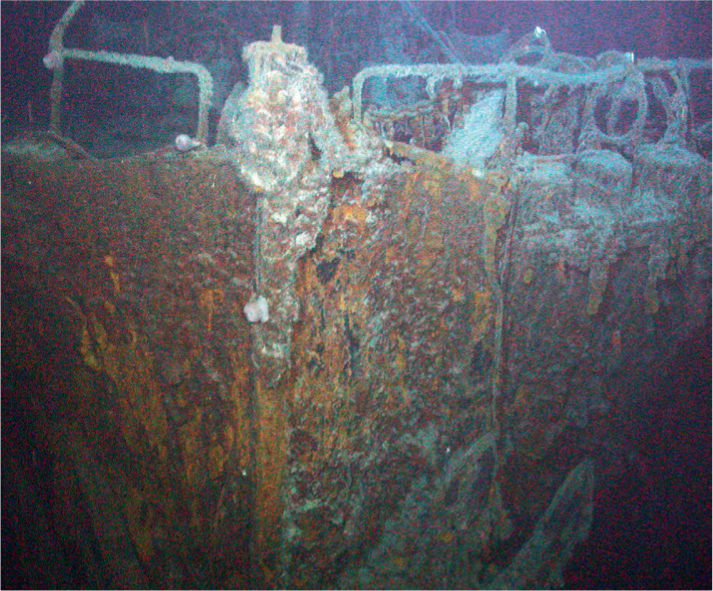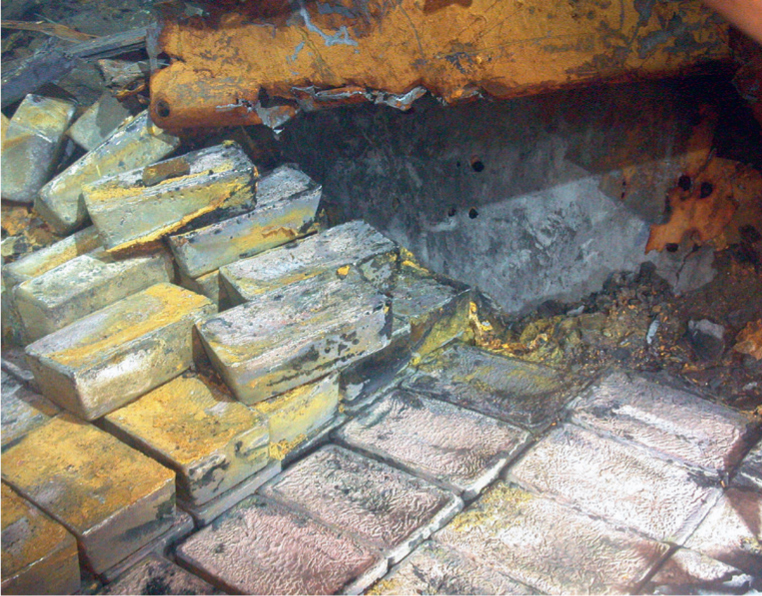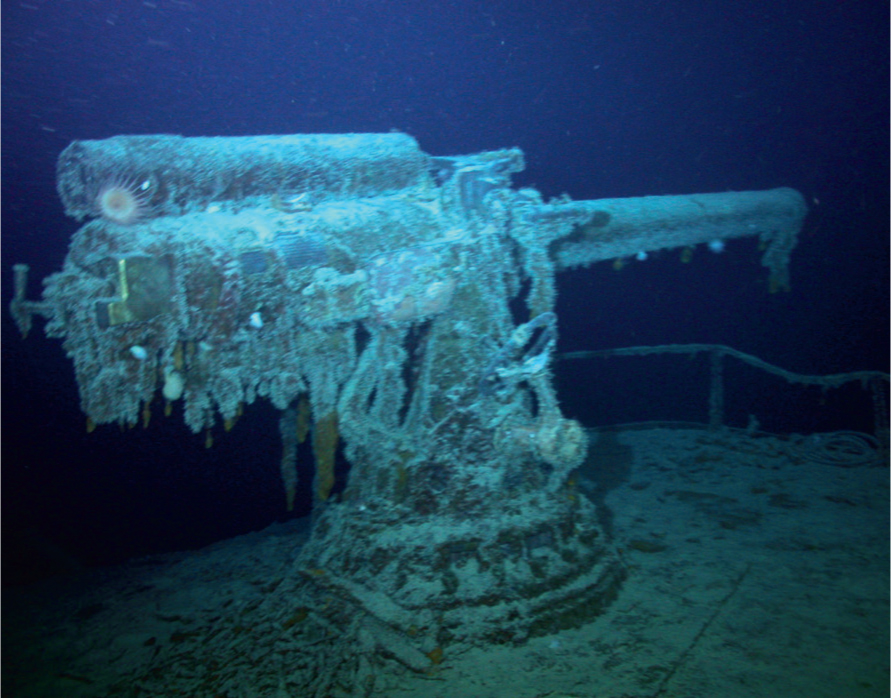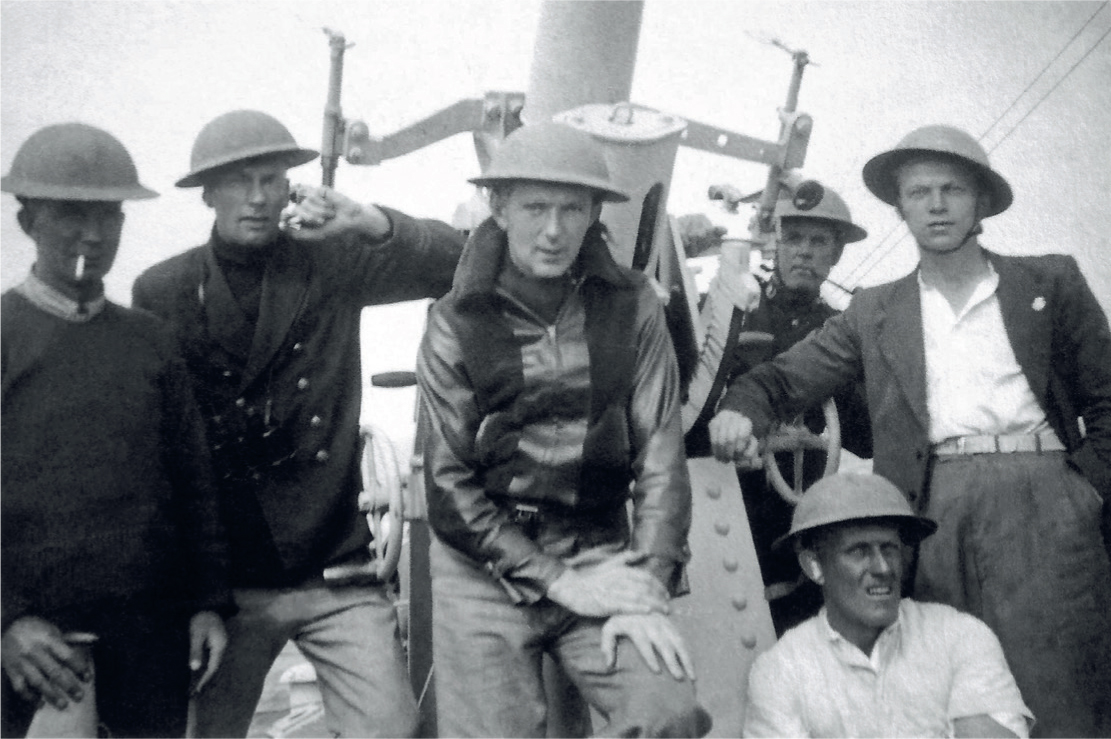A History of the World in Twelve Shipwrecks (41 page)
Read A History of the World in Twelve Shipwrecks Online
Authors: David Gibbins


The bow of the SS
Gairsoppa
as seen at a depth of 4,700 metres some 240 nautical miles off the coast of Ireland, taken by a remotely operated vehicle from
Odyssey Explorer.

Silver bars in the wreck of the
Gairsoppa
, part of a consignment of some 200 tons of silver lost when the ship was torpedoed on 16 February 1941.

The 4-inch gun of the
Gairsoppa
, still in position with its barrel pointing aft.

Lawrance Wilfred Gibbins, second left, with his gun crew on board the SS
Clan Murdoch
, also in a convoy from Sierra Leone and in action against German aircraft on the day that the
Gairsoppa
was sunk.
From Landewednack Church it is a short walk to Lizard Point, the southernmost promontory of England overlooking the entrance to the English Channel. From here the open expanse of the Atlantic extends from Newfoundland to Africa, from the seas plied by Viking explorers to the route to the Mediterranean and south to the Cape of Good Hope, to India and China and beyond. Standing on the cliffs it would have been possible to see several of the vessels in this book pass by: the Dover Boat or others like it, taking tin across the English Channel that would eventually reach the Bronze Age civilisations of the Near East; the
Mary Rose
, patrolling the Channel under orders from Henry VIII; the
Santo Cristo di Castello
, sailing close to these cliffs with its extraordinary cargo from Amsterdam, only to be beaten back by the wind and wrecked just round the corner; and the
Royal Anne Galley
, plying the same route with passengers and gold for the Caribbean but making it no further than the Man O'War rock just a few hundred metres away. Within sight of this spot the three girls saw the boat from the
Gairsoppa
coming ashore, open to the elements and pitted against the sea just as mariners had been at the time of the Dover Boat.
I began this book with a quote from the historian Fernand Braudel about the sea being the greatest document of its past existence. This history of the world is one of many that could be written from the shipwrecks that litter the ocean floor, each one a microcosm of their time, able to tell a story from the wide historical canvas to the lives of individuals. Like any historical narrative, it is personal and subjective â it reflects the sites that have fascinated me over more than four decades of exploration, a constantly evolving process that has made writing this book itself an exciting adventure. Above all it is my own passion as a diver and archaeologist that has drawn me on, with each new wreck offering the potential for unique insights and artefacts. The very act of diving, in an unfamiliar and often challenging environment, sharpens the resolve and heightens awareness, as if by doing so we are entering into the final moments of emotion of those on board
and able to sense the lives that still seem to be imprinted on the seabed.
That connection with individual experience gives archaeology great power as a historical tool, building on the meaning of material culture in our own lives and seeing artefacts from the past in the same way. In this book, as well as the backdrop of trade, warfare and exploration that each wreck represents, it is the individuals that stand out â small but intensive vignettes of people and their lives, some of them famous but many otherwise unknown. From the Bronze Age we have Queen Nefertiti and the warrior-kings of the Homeric age, and a metal merchant of Ugarit who writes fearfully to his king; from the classical period, the philosopher Plato and an eye-surgeon from the time of the great doctor Galen; from the time of the Arabian Nights, a real-life Sinbad and the merchants of Baghdad and China; from the Age of the Vikings, Leif Erikson and the explorers of the Atlantic and Danube; from the Tudor period, King Henry VIII and his wife Katherine of Aragon, and an unnamed archer at the top of his profession; from the following century, the remarkable figures of Rembrandt and Athanasius Kircher; from the nineteenth century, Captain Franklin and his officers sitting for daguerreotypes and in their cabins reading works of science and geography and religion as they await near-certain death; and in the dark days of 1941, the figure of Richard Ayres and the men with him, representing the eternal truths of endurance at sea and a maritime culture of ethnic diversity and few boundaries, people constrained by the sea but also drawn by its possibilities and the lure of what lies just beyond the horizon â just as for me as a diver and explorer.
On Lizard Point itself, the powerful beam of the lighthouse and the blast of the foghorn are a reminder of the danger of shipwreck even today, and of what lies just offshore. Those who have been fortunate enough to go underwater, and those who have read about it and been mesmerised by the images, know that to strip away the sea would be to expose the great document of its past â innumerable shipwrecks, many of them uncharted and unknown, an endlessly unfolding tapestry that will continue to reveal riches as long as we are able to explore the ocean depths and bring its history to light.
I am very grateful to my agent, Luigi Bonomi of LBA, to my editors Maddy Price and Ed Lake at Weidenfeld & Nicolson and Charles Spicer at St Martin's Press, and to the excellent teams at both publishers â including Susie Bertinshaw, Natalie Dawkins, Elizabeth Allen, Tara Hiatt, Hannah Pierdolla, Sophia Lauriello and Sara Beth Haring. Many people have helped to further my career as a diver and archaeologist, including, in Canada, Tom D'Entremont, Anna Pond, Ken Oldridge, Scott Jordan and Steve Aitken; at the University of Bristol, Dr Toby Parker, Professor Peter Warren and Brian Warmington; at Cambridge, Henry Hurst, Dr Catherine Hills, Professor Anthony Snodgrass, Dr Richard Bainbridge and Dr James Kirkman OBE; at the British Institute of Archaeology at Ankara, Alan Hall; and at the Institute of Nautical Archaeology, Professor George Bass. I am grateful to the many divers and friends who made my expeditions to Sicily possible, including diving officers Roddy Maddocks, Gavin Nelson, Dr Doron Cohen, Dr Chris Edge and Jim Coates; in Turkey, to Dr Deborah Carlson and the team that she and George Bass directed at Tekta
Å
in 1999â2000, and to Dr Cemal Pulak, Dr William Murray and Dr Ken Trethewey; and in Cornwall to Mark Milburn, Ben Dunstan, Nick Lyon and many other friends who have dived with me. Mark Milburn co-founded Cornwall Maritime Archaeology with me as a research group in 2015, and his enthusiasm, knowledge and friendship were instrumental in the wreck projects off Cornwall described in this book. For help with research related to those wrecks I am grateful to Lucy Elliott and her family, David and Peter McBride, Kevin Camidge, Charles Johns and Ritzo Holtman; at the Museum of Cornish Life in Helston, to Annette MacTavish; at the Shipwreck Treasure Museum in Charlestown, to Daniel Scholes; at Historic England, to Hefin Meara and Terry Newman; at The National Archives, to Dr Randolph Cock and Dr Amanda Bevan; and in Genoa, to Dr Luca Lo Basso and Renato Gianni Ridella.
I owe special thanks to Dr Sean Kingsley of
Wreckwatch
for much
assistance during the research for this book, and I am grateful to him and to Greg Stemm (Seascape Artifact Exhibits Inc.) for imagery of the SS
Gairsoppa
. Jonathan Moore of Parks Canada's underwater archaeology team provided invaluable comments on the
Terror
chapter as well as images from the ongoing Parks Canada investigation at the site. For photos of the
Mary Rose
, I am very grateful to Dr Alex Hildred of the Mary Rose Trust; for the Marzamemi Church Wreck, to Dr Elizabeth Greene; for the Belitung wreck, to Dr Michael Flecker; for the Dover Boat, to Keith Parfitt and to Alison Hicks of the Canterbury Archaeological Trust; for the Uluburun and classical Greek wrecks, to Dr Rebecca Ingram of the Institute of Nautical Archaeology; and for the Viking longship, to Tilde Yding Abrahamsen at the National Museum of Denmark, with thanks also to Dr Athena Trakadas and to Kyle Forsythe of the Royal Alberta Museum.
I am very grateful to Rachel Hipperson, Professor Aaron Ridley, Dr Henry Mallorie, Dr Vilma Arce-Arenales, Gerhard Kapitän, Professor Mike Fulford CBE, Professor Angie Hobbs, Rosemary Hobbs, Dr Margaret Rule CBE, Professor Jon Adams, Dalya Alberge, Professor Alice Roberts, Sir Tim Smit and Mensun Bound. My career would not have been possible without the support of my family, including my grandparents, my parents Ann and Norman, my brothers Alan and Hugh and my daughter Molly, who dived with me again on the wreck of the
Santo Cristo di Castello
while I was writing this book.
In order to share the sources used in researching this book, you can access the bibliography and resources on my website:
www.davidgibbins.com
The index that appeared in the print version of this title does not match the pages in your e-book. Please use the search function on your e-reading device to search for terms of interest. For your reference, the terms that appear in the print index are listed below.
- Abbasid Islam
- Abercromby, Patrick,
The Martial Achievements of the Scots Nation - Abkhazia
- Abydos boat
- Accelerator Mass Spectrometry (AMS)
- Achaean people
- Acropolis
- Act of Supremacy (1534)
- Actium, Battle of (31
BC
) - Admiral Hipper
- Adulis, Eritrea
- Aegean islands
- Aegean Sea
- Aeschylus,
The Suppliants - Afghanistan
- Africa
- Africa Proconsularis
- Africa, west
- âAfrican Colonization Expedition' (1840)
- Agamemnon
- âAge of Heroes'
- âAge of Pericles'
- agriculture
- Aigle
- Aikman, William
- Akhenaten
- Akkadian cuneiform
- Aksum Kingdom
- Akurgal, Ekrem
- Albert
- Albert, Prince
- Albinus, Clodius
- Alcuin
- Alexander the Great
- Almeda Star
, SS - alphabets
- Amalasuntha, Queen
- Amarna site, Egypt
- amber analysis
- ambos
- Amenhotep IV
- Ammurapi
- amphoras
- forms
- inscriptions
- sherds
- stamps
- Tekta
Å
Burnu site - Uluburun jars
- Amsterdam
- Amundsen, Roald
- Anchors
- Anglo-Saxon Chronicle
- Anne, Queen
- annona
(foodstuffs import) - L'Anse aux Meadows, Newfoundland
- Anson
, HMS - Anthony Roll (depiction of
Mary Rose
) - Antikythera mechanism (astronomical calculator)
- Apollonius of Tyana
- Aquae Sulis (Bath)
- Aras, Kemal
- Arawa
, HMS - âArcher Royal' (
Mary Rose
) - Argoli, Andrea
Pandosion sphaericum - Argyll, John Campbell, Duke of
- Arian Christianity
- Arikamedu site, Pondicherry
- Aristotle
- artefact typology
- artefacts
- Belitung site
- Changsha bowls
- Greek
- HMS
Terror - HMS
Terror - Mary Rose
- Plemmirio wreck
- Royal Anne Galley
- Santo Cristo di Castello
- SS
Gairsoppa - Viking
- Artemis
- Artemisium sculpture
- Athena Parthenos, Temple of
- Athens
- Athlit ram
- Atlantic, Battle of the (1939â45)
- Atlantis
- Attica
- Augustine, St,
City of God - Augustus
- Australia
- Austvard
- Avery, âLong Ben'
- axes, bronze
- Ayres, Richard Hamilton
- Back, George
- Baffin Bay
- Baghdad
- Bai Juyi
- Bailey, Donald
- Bakhuizen, Ludolf,
Ships in Distress off a Rocky Coast - ballads, broadside
- Barbados
- Barbary pirates
- barber-surgeons
- barrows, burial
- Bass, Ann
- Bass, Prof George
- Bassano, Anthony
- Basso, Capt Antonio
- Bayeux Tapestry
- Bayt al-Hikma (âHouse of Wisdom'), Baghdad
- Beagle
, HMS - Beaker Folk
- Bedford
, HMS - Beechey, Capt Frederick William
- Beechey Island
- Belhaven, John Hamilton, Lord
- belief systems
- Belisarius
- Belitung, Indonesia
- Belitung site
- Bellerophon
, HMS - bells, diving
- âbends', the
- Benedict of Nursia,
Regula Sancti Benedicti - Benzi (agent)
- Berber peoples
- Bering Strait
- Bhagavaddharma
- bills of lading (
Sacrificio d'Abramo
) - Bismarck
- black glaze, Greek
- Blaeu, Johan
- Blaeu, Willem,
Atlas Maior - Blanckerhoff, Jan
- Bletchley Park
- Bai Juyi
- Boardman, Prof Sir John
- Bodrum Museum of Underwater Archaeology
- Boleyn, Anne
- Bolivia
- Bonaparte, Alexandrine
- Boni Kingdom
- bowls
- Brandão, Francisco Rodrigues
- brass figures
- Braudel, Fernand xi
- Brazil
- Brendan (monk)
- Britain
- British Army
- British India Steam Navigation Company
- Bronze Age
- DNA analysis
- middle
- overseas trade
- seafaring
- tools
- wrecks
- bronzesmiths
- bronzework
- Belitung wreck
- guns
- instrument
- mirrors
- rams
- Riace
- sculptures
- smelting
- Brunel, Isambard Kingdom
- brushwood dunnage
- Brydon, Dr William
- Buddhism
- Burial of Drowned Persons Act (1808)
- burial practice
- Burma
- Burton, Sir Richard
- Butler, Lady,
The Remnants of an Army - butternut trees
- Byzantine sites
- Byzantines
- Byzantium, early
- Cabot, John
- Caerthillian Cove, Lizard Peninsula
- Caesar, Julius
- Cairo
- Ãakir, Mehmet
- calligraphy
- Calypso
- Campin of Tournai, Robert
- Canaanite jars
- Canada
- Canadian Arctic
- cannibalism
- Canterbury Archaeological Trust
- Cape Artemisium site
- Cape Gelidonya site
- Caracalla
- Carew, Vice-Admiral George
- Caribbean islands
- Carlson, Dr Deborah
- Carmichael, John Wilson
- carracks (four-masted ships)
- Carter, Howard
- Carthage War (218â202
B
C
) - Carthaginians
- Cartier, Jacques
- Cassiodorus
- Cassiterides (âTin Isles')
- Cathedral of Our Lady, Antwerp
- cauldrons, cooking
- cave art
- cedar of Lebanon
- Celsus,
De Medicina - Chambers, Robert,
Vestiges of the Natural History of Creation - Changsha Ware
- Charge of the Light Brigade (1854)
- chariots
- Charles II, King
- Charles V of Spain
- China
- Chios island
- Christianity
- altarpieces
- Arian
- artefacts
- conversions to
- devotional books
- early
- Henry VIII and
- Huguenots
- iconography
- libraries
- Moors and
- Nicene
- symbolism
- Churchill, Winston
- civilisations, early
- Clan Cumming
, SS - Clan Fraser
, SS - Clan Line
- Clan Murdoch
, SS - Clan Ogilvie
, SS - The Classic of Tea
- clay tablets
- Clement VII, Pope
- Cleopatra, Queen
- Clockmaker's Company
- Cloots, Paulus
- cloth/clothing
- Clowes, William
- Cnut
- cod fishing
- âcodex' form
- coinage
- copper-alloy
- Gairsoppa
coins - gold
- moidores
- pieces of eight
- silver
- Collier, Joseph
- Collins, Wilkie
- Colossus
, HMS - Colston, Richard
- Columbus, Christopher
- columns, church
- Constantine the Great
- Constantinople
- Conway
, HMS - Cooke, Capt James
- Copenhagen, Battle of (1801)
- copper
- ingots
- Corinthian War, (395â387
BC
) - Cornwall
- Cornwall Maritime Archaeology
- Corsi, Piero Paola
- Cosmas Indicopleustes
- cotton industry
- Council of Trent (1545â63)
- Cousteau, Jacques
- Cowdray Engravings (1788)
- Crete
- Cromwell, Thomas
- Crozier, Capt F.R.M.
- Cumby, William
- cuneiform script
- Cup of Nestor
- cups
- currach (Irish boat)
- Cyclopes
- Cyprianus
- Cyprus
- da Gama, Vasco
- daguerreotypes
- Damascus
- Darwin, Charles,
On the Origin of Species - de Strzelecki, Sir Paul Edmund,
Physical description of New South Wales and Van Diemen's Land - Dead Pool, Cornwall
- Deane, John and Charles
- decompression
- Defoe, Daniel,
Robinson Crusoe - DeGrusty, John
- Delian League
- Delphi
- Demetrios, St
- dendrochronology
- Denmark
- Desaguliers, John Theophilus,
A Course of Experimental Philosophy - dhow
- Dias, Bartolomeu
- Dickens, Charles
- dietary evidence
- Dio, Cassius
- Diocletian
- Diodorus Siculus
- diversity, of finds
- diving equipment
- âEngine'
- DNA analysis
- Dnieper river
- dogs
- âDomesday' stone
- Domna, Julia
- douçaine (double-reed instrument)
- Dover
- Dover Boat
- replica
- Dover Museum
- Draco, Iunius
- Drake, Sir Francis
- Dressel, Heinrich
- Druids
- Dudley, John
- Dumas, Frédéric
- Dunstan, Ben
- Duthuit, Claude
- dysentery
- East India Company, Dutch
- East India Company, English
- east Mediterranean
- ebony
- Edge, Dr Chris
- Edwards, William
- Egadi Islands, Battle (241
BC
) - Egypt
- annexation
- funerary barges
- libraries
- pharaohs
- pottery
- religion
- sculpture
- Thutmose I
- war and
- EirÃks Saga Rauða
- Eiriksson, Thorvald
- Elagabalus
- Elcano, Juan Sebastián
- elephants
- Elgin Marbles
- Elizabeth I, Queen
- Elizabeth II, Queen
- Ellesmere Island
- Emma of Normandy
- Empire Elaine
(assault ship) - Encomium Emmae Reginae
- Enlightenment, Age of
- Epic of Gilgamesh
(poem) - Erasmus
- Erebus
, HMS - Erik the Red
- Erikson, Leif
- Erythrae
- Erythraean Sea
- Ethiopia
- Etruscan civilisation
- Europa and the bull
- Evans, Capt William
- Evans, William (son)
- eye surgery
- Fairholme, James Walter
- Ferdinand of Aragon
- Ferriby boat
- Field of the Cloth of Gold (1520)
- figurines
- First World War
- fish produce
- Fitzjames, Capt James
- Fitzroy, Capt Robert
- Flecker, Dr Michael
- Flinders, Matthew
- Flodden Field, Battle of (1513)
- Fourth Crusade (1202â1204)
- France
- Francis I of France
- Francis, Jacques
- Franklin family
- Franklin, Lady Jane
- Franklin, Sir John
- Franklin Monument, London
- Freetown, Sierra Leone
- Frobisher, Martin
- Frost, Honor
- funerary barges
- Fyfe, Peter Ewing
- fyrenne dracan
(Viking ship) - Gabon
- Gagnan, Emile
- Gairsoppa
, SS - Galapagos Islands
- Galen
- Ganges
, HMS - Genoa
- George, Prince of Wales (
later
George II) - Germany
- Germany, southern
- Geta
- Ghana
- Gibbins, Lawrance Wilfred
- Gibbins, Molly
- Gibbon, Edward,
The History of the
Decline and Fall of the Roman Empire - Gibraltar
- gift-exchanges
- Giotto di Bondone
- Giovanni da Montecorvino
- glass ingots
- Goa
- Göbekli Tepe, southern Anatolia
- Godolphin family
- Godolphin, Francis
- Godwinson, Harold
- Gogra
- Gokstad ship burial
- gold
- Belitung wreck
- coins
- cups/vessels
- Egyptian
- jewellery
- mines
- ornaments
- rushes
- scarab
- Uluburun wreck
- âGolden Age', Dutch
- Goldsmith, Oliver
The Vicar of Wakefield - Goodfellow, Capt William West
- Goodsir, Dr Harry
- Gore, Lt Graham
- Goths
- graffiti
- Grand Congloué, Marseilles site
- Grand Louise
- âGrand Tourists'
- Great Compassion Dharani S
u
Ë
tra - Great Harry
- Great Orme, north Wales